Any leadership transition can be hard for an institution, but CFO/CBO transitions appear to be especially challenging for technology teams. Early and frequent communication with new leaders, as well as strategic alignment, can help.

EDUCAUSE is helping institutional leaders, IT professionals, and other staff address their pressing challenges by sharing existing data and gathering new data from the higher education community. This report is based on an EDUCAUSE QuickPoll. QuickPolls enable us to rapidly gather, analyze, and share input from our community about specific emerging topics.Footnote1
The Challenge
Among higher education's many pandemic-era challenges, staff turnover has been one of the most concerning for institutions' long-term viability and success. Although some signs indicate that turnover rates are slowing,Footnote2 they remain higher than pre-pandemic rates and still demand our attention. In particular, turnover among top levels of leadership presents unique institutional challenges for strategic and business continuity and requires concerted planning and action across the campus.
The Bottom Line
Most respondents reported experiencing some form of leadership transition over the past year. And while most respondents expressed generally positive sentiments—or at least an absence of negative sentiments—about those transitions, specific aspects of those transitions may be having more of a negative impact than others. More than president or provost transitions, chief financial officer (CFO) / chief business officer (CBO) transitions are especially challenging for technology teams to navigate and adapt to, and multiple concurrent leader transitions may further exacerbate these challenges. Communication, flexibility, and strategic alignment are among the strategies respondents recommended for navigating these leadership transitions.
The Data: The Current Landscape of Leader Transitions
For this QuickPoll our sample consisted primarily of CIOs (or equivalent IT leadership roles), IT directors, and other IT staff. Our questions focused on personnel transitions in three key areas of leadership at the institution: the president/chancellor/CEO, the CFO/CBO or equivalent, and the provost or equivalent. The majority of respondents (65%) reported a transition in at least one of these roles over the past 12 months (see figure 1), with 22% of respondents reporting two of these role transitions and 10% reporting transitions in all three. Fewer respondents (25%) expect transitions in any of these roles in the coming months (see figure 2).
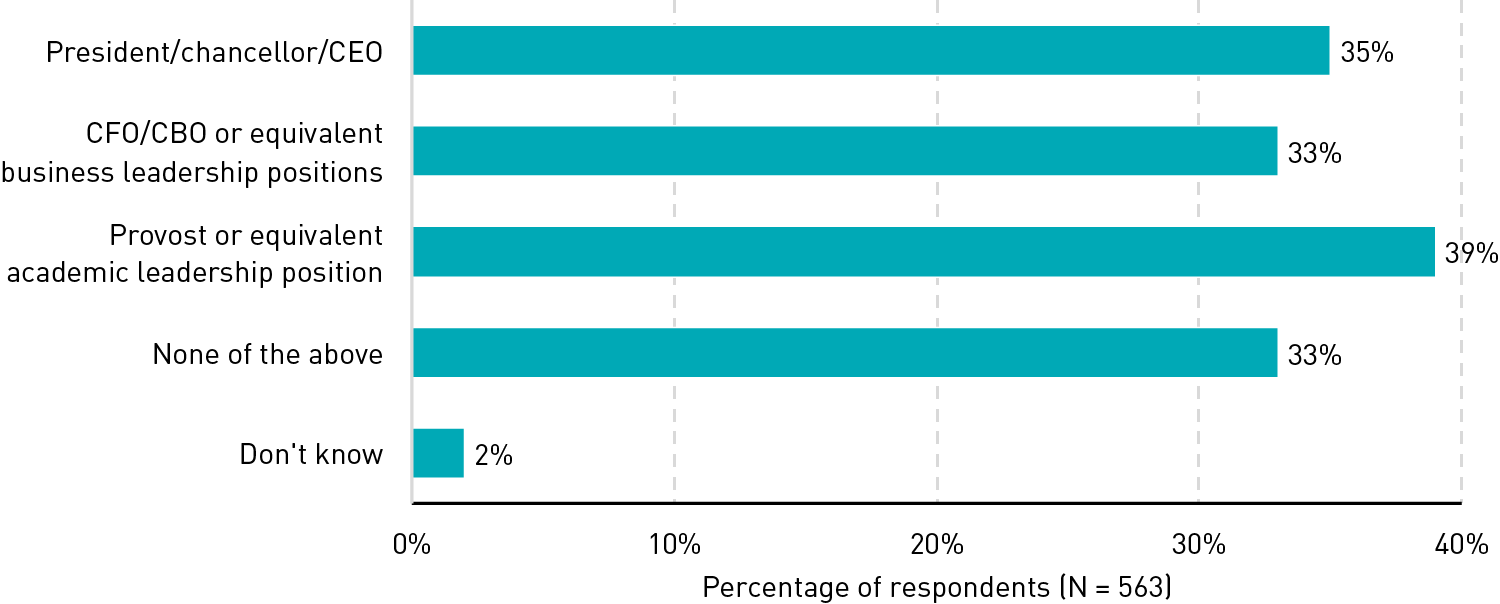
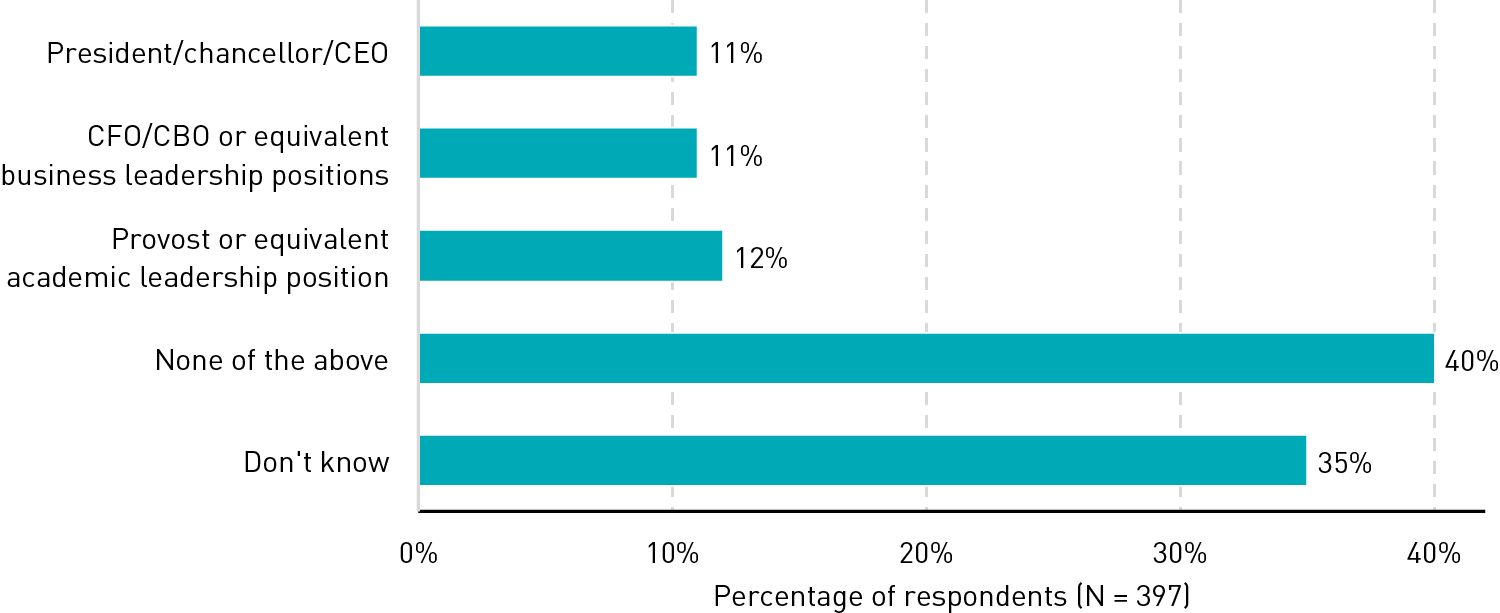
Slight majorities of respondents were optimistic about their recent president and provost transitions for the long-term health and success of their institution (see figure 3). Notably fewer respondents were optimistic about CFO/CBO transitions.

Asked if their new president, CFO/CBO, or provost is supportive of their team's strategy and goals for the future, majorities of respondents simply don't know (see figure 4). Very few respondents reported that their new leadership is not supportive of their team, though slightly more reported so for their new CFO/CBO (12%) than for presidents or provosts.
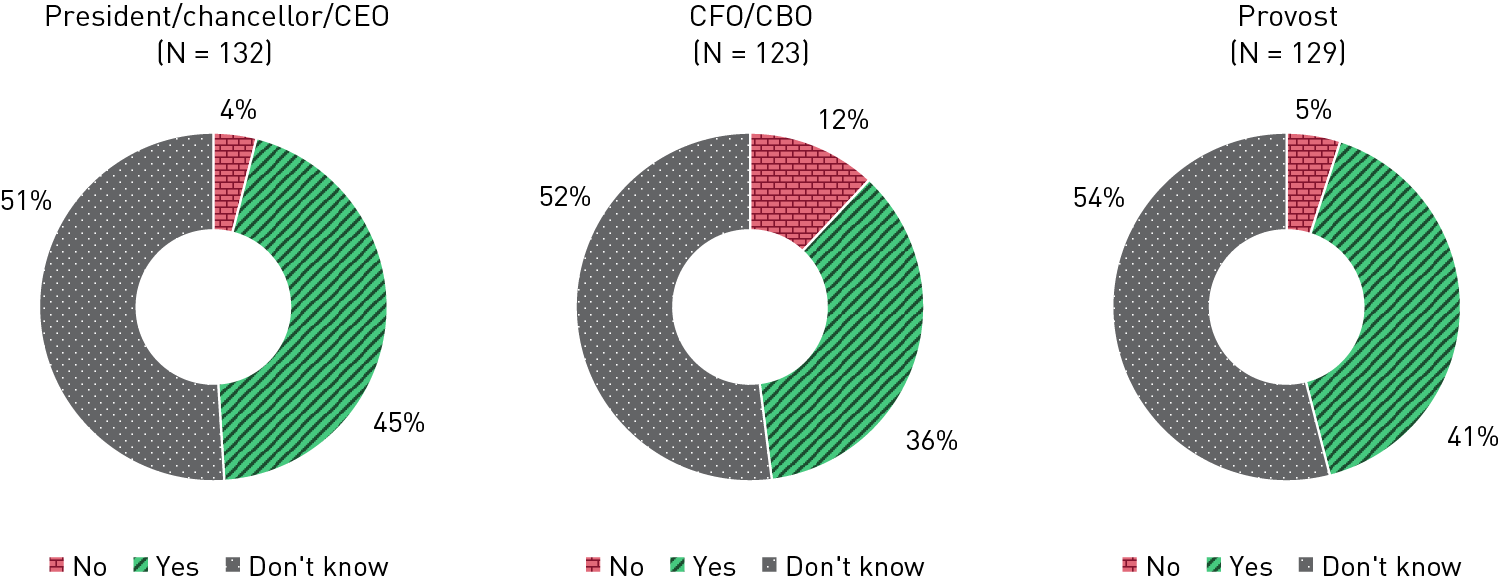
Though our data can't support causal conclusions, there may be a compounding effect when an institution undergoes multiple leader transitions within the same year. Optimism about the long-term health and success of the institution was significantly lower for respondents reporting more than one leadership transition in the past 12 months than for respondents reporting only one leader transition. For example, 87% of respondents reporting only a president transition were optimistic about the long-term health and success of their institution, but this drops to 70% among respondents reporting a president transition and a transition for one or both of the other leaders.
The Data: The Impacts of Leader Transitions
Majorities of respondents reported that they have been able to successfully navigate and adapt to these leadership transitions, and very few reported that they have not (see figure 5). Just over a third of respondents, however, reported that they "don't know" if they have been able to successfully navigate and adapt to these transitions, perhaps suggesting that these transitions are still too new to assess or that some technology professionals may simply be more isolated than others from the effects of these transitions.
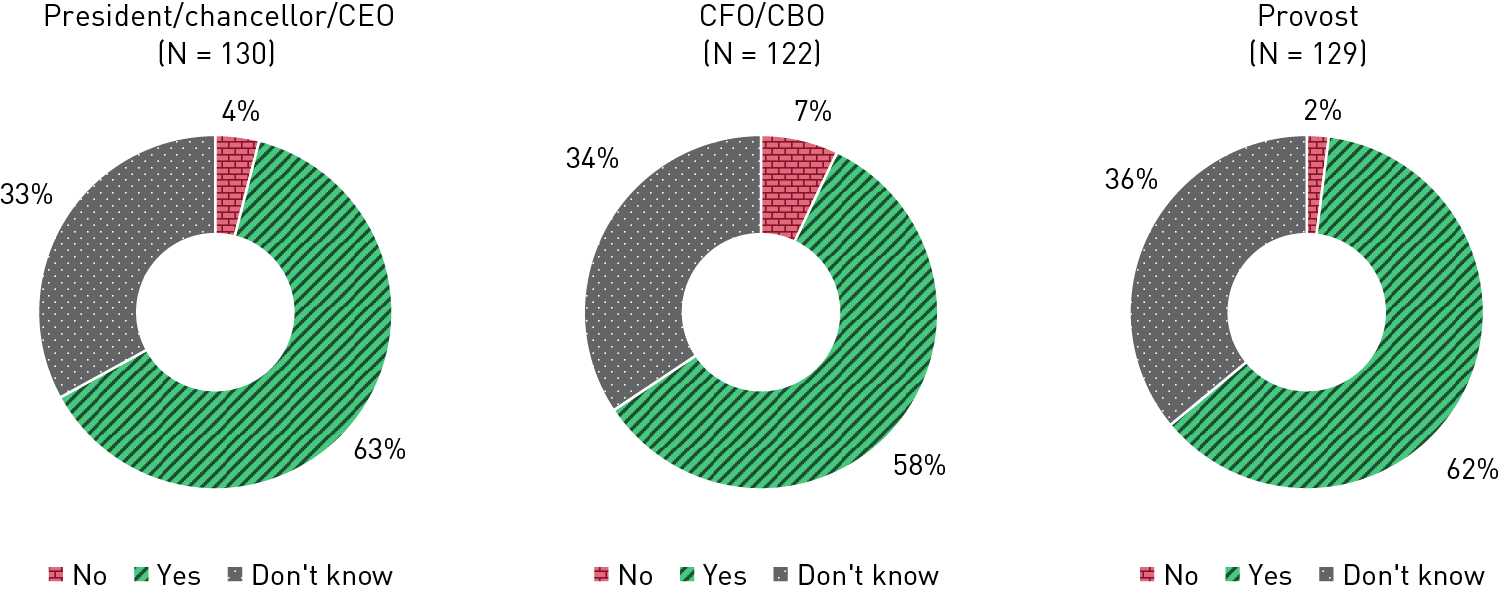
Looking at specific aspects of respondents' work, adapting to these transitions might be more or less challenging for particular areas. Across all three types of leadership transition, for example, less than a quarter of respondents reported negative impacts on their own personal strategic influence at the institution (see figure 6). Consistently larger proportions of respondents, however, reported that these transitions have had a negative impact on areas such as institutional culture, the institution's strategic priorities, and staff morale.
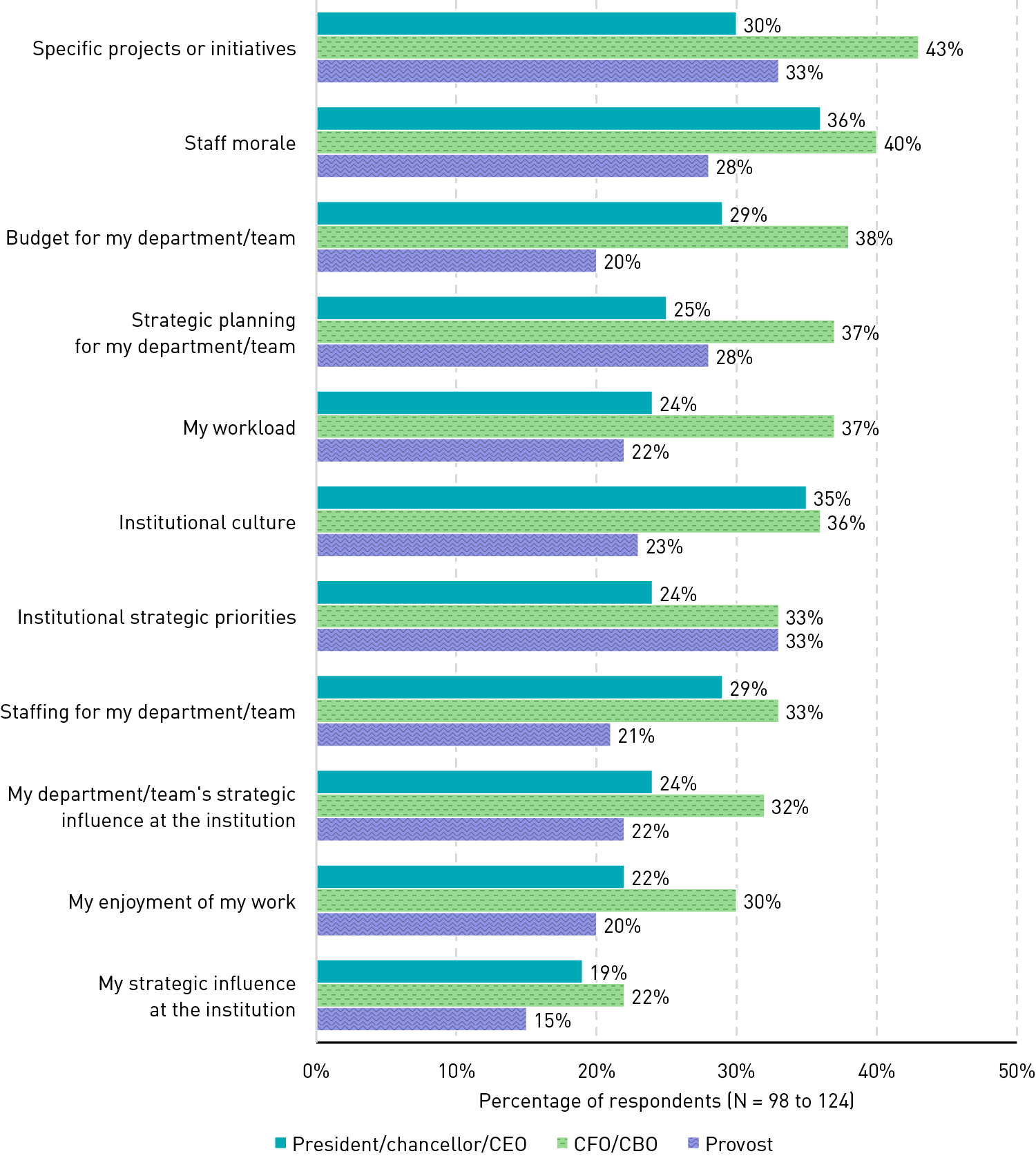
Almost across the board, more respondents reported negative impacts from CFO/CBO transitions than from president or provost transitions. A full 43% of respondents reported that specific projects or initiatives were negatively impacted by a CFO/CBO transition, for example, compared with 30% and 33% for president and provost transitions, respectively. While only 24% and 22% of respondents reported that president and provost transitions negatively impacted their workload, 37% reported the same for CFO/CBO transitions. Even for institutional culture, the negative impact of a CFO/CBO transition is just slightly higher than that of a president transition.
The Data: Advice for Navigating Leader Transitions
Asked what advice they had for successfully navigating leader transitions, respondents shared a range of responses that, taken together, coalesce into complementary, balanced strategies for navigating these changes.
Communicate early, openly, and frequently. Engage in intentional and early outreach to new leadership soon after they arrive on campus, and work to establish foundational expectations of relationships built around transparent and regular communication. Be a partner that new leadership can talk to, have easy access to, and trust.
… but also …
Be patient. Leadership transitions take time, and it can sometimes take months or even longer for new leaders to learn their new institution, establish their own priorities and goals, and implement important decisions or projects. Give new leaders an opportunity to get their feet under them before rushing to judgment or pushing them too hard too early.
Have your ducks in a row. Document your work, processes, and goals and be prepared to show your new leadership what you and your team can offer the institution. Having data on hand to showcase your team's success, and to demonstrate resource needs, can go a long way to gaining support from a new leader.
… but also …
Be flexible. New leaders often bring new priorities and ideas with them, and transitions often lead to widespread change across the institution. Be open to listening to your new leaders' ideas and needs, and be open to reconsidering and changing the ways you work. New leadership can be an opportunity for learning and growth.
Clarify and align to institutional strategy. Understanding your institution's strategic priorities can help with more effectively communicating your team's value to the institution and with gaining support from new leadership on project and resource needs. Alignment with the institution's strategy, and maintaining a focus on the "bigger picture," can also ensure more stability for your team across transitions.
… but also …
Stay grounded. Remember to stay focused on the day-to-day work in front of you and on your team. Effectively doing "the work of the work" can go a long way toward building trust and support from new leadership. Also remember to keep your focus on the people around you. Leader transitions can be hard for everyone, and your colleagues and team will need your support and guidance through those changes.
Common Challenges
Those few respondents who reported that they have not been able to successfully navigate their leadership transition(s) were asked about the primary challenges they encountered.
Lack of vision or direction. Several respondents noted their frustrations either with new leadership's apparent lack of a clear vision for the institution or for the leader's role or with new leaders who were keeping their ideas and decisions behind closed doors or were otherwise not communicating with staff openly or transparently.
Lack of access. Respondents also voiced frustration with an inability to gain access to or easily communicate with new leaders. Several respondents further noted that other departments or teams, for whatever reason, appeared to have more direct access to their new leadership than they did.
Promising Practices
Those respondents who reported that they've successfully navigated leadership transition(s) were asked about the factors that contributed most to their success.
Building relationships now with "future leaders." Many respondents were already familiar with the new leaders, either because they were internal hires or interim leaders that transitioned into a permanent appointment. When external hires were made, some respondents cited their role on the hiring committee as critical for building those relationships early on. Technology leaders who are proactive in engaging with other teams across the campus and who are involved in important strategic processes and decisions can benefit from this proactive engagement in the long term.
Understanding your circle of control. At the end of the day, technology leaders and staff likely will not be the sole, final decision-makers about who gets to be their new president, CFO, or provost. Respondents acknowledged that these leader transitions are ultimately out of their control and cited their ability to recognize this reality and remain focused on the things that are within their control as critical for making peace with changes in leadership.
All QuickPoll results can be found on the EDUCAUSE QuickPolls web page. For more information and analysis about higher education IT research and data, please visit the EDUCAUSE Review EDUCAUSE Research Notes topic channel. For information about research standards, including for sponsored research, see the EDUCAUSE Research Policy.
Notes
- QuickPolls are less formal than EDUCAUSE survey research. They gather data in a single day instead of over several weeks and allow timely reporting of current issues. This poll was conducted between May 13 and May 14, 2024, consisted of 29 questions, and resulted in 563 responses for analysis. The poll was distributed by EDUCAUSE staff to relevant EDUCAUSE Community Groups rather than via our enterprise survey infrastructure, and we are not able to associate responses with specific institutions. Our sample represents a range of institution types and FTE sizes. Jump back to footnote 1 in the text.
- CUPA-HR, "Voluntary Turnover in the Higher Ed Workforce Is Trending Downward," The Higher Ed Workplace Blog, May 8, 2024. Jump back to footnote 2 in the text.
Mark McCormack is Senior Director of Research and Insights at EDUCAUSE.
© 2024 Mark McCormack. The content of this work is licensed under a Creative Commons BY-NC-ND 4.0 International License.
